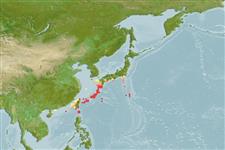>
Blenniiformes (Blennies) >
Blenniidae (Combtooth blennies) > Salariinae
Etymology: Cirripectes: Latin, cirrus = curl fringe + Greek, pektos, -e, -on = made of several parts solidly united (Ref. 45335); imitator: Specific epithet meaning 'mimic', referring to the similarity of the color pattern to that of C. polyzona and C. castaneus..
Environment: milieu / climate zone / depth range / distribution range
Ökologie
seewasser riff-verbunden; tiefenbereich 0 - 10 m. Tropical; 35°N - 20°N
Western Pacific: Shirahama, Japan and the Ogasawara Islands to Batan Islands, northern Philippines.
Length at first maturity / Size / Gewicht / Alter
Maturity: Lm ?, range 6 - ? cm
Max length : 9.3 cm SL Männchen/unbestimmt; (Ref. 529)
Rückenflossenstacheln (insgesamt): 11 - 13; Rückenflossenweichstrahlen (insgesamt): 13-15; Afterflossenstacheln 2; Afterflossenweichstrahlen: 14 - 16; Wirbelzahl: 30. Diagnosis: Dorsal fin XII, 14, membrane attached to caudal fin, with deep notch above last spine, first spine almost same or slightly higher than second; anal fin II, 15; pectoral rays 15; pelvic fin I, 4; caudal fin procurrent rays 11-14. Vertebrae 10 + 20. LL, without scales and scalelike flaps; LL tubes 7-14, canal ends below posterior to 9th dorsal ray, usually on caudal-fin base. Lower lip smooth mesially, plicate laterally. Upper lip crenulae 36-50. Gill rakers 24-27. Cephalic sensory pore system complex. Cirri, nuchal 40-59, supraorbital 13-46, nasal 9-93; 4 groups of nuchal cirri, 2 groups on 1 side rarely connected by a low basal membrane, ventralmost group on each side borne on enlarged nuchal flap. Body depth at anal-fin origin 3.5-4.0 in SL. Morphometric and meristic characters does not vary geographically. Overall dark brown; female with pale grey polygonal spots; male with irregular bars and yellow tips on caudal fin and anterior dorsal spines; irregular pupil- sized spots on head; iris with yellow-ringed pupil (Ref. 529, 90102).
Facultative air-breathing in the genus (Ref. 126274); Adults inhabit shallow coral and rocky reefs (Ref. 90102). Oviparous. Eggs are demersal and adhesive (Ref. 205), and are attached to the substrate via a filamentous, adhesive pad or pedestal (Ref. 94114). Larvae are planktonic, often found in shallow, coastal waters (Ref. 94114).
Oviparous, distinct pairing (Ref. 205). Urogenital orifice of male genital papilla located basally between 2 widely separated slender filaments on a fleshy swelling behind anus; testes bulbous with length equal to its width (Ref. 529).
Williams, J.T., 1988. Revision and phylogenetic relationships of the blenniid fish genus Cirripectes. Indo-Pac. Fish. (17):78 p. (Ref. 529)
IUCN Rote Liste Status (Ref. 130435)
Bedrohung für Menschen
Harmless
Nutzung durch Menschen
Fischereien: nicht kommerziell
Mehr Information
ReferenzenAquakulturAquakultur ProfilZuchtlinienGenetikElectrophoresesVererbbarkeitKrankheitenVerarbeitungNutrientsMass conversion
PartnerBilderStamps, Coins Misc.LauteCiguateraGeschwindigkeitSchwimmstilKiemenoberflächeOtolithsGehirngrößeSehfähigkeit
Tools
Zusatzinformationen
Download XML
Internet Quellen
Estimates based on models
Preferred temperature (Ref.
123201): 22.7 - 26.9, mean 25.2 °C (based on 102 cells).
Phylogenetic diversity index (Ref.
82804): PD
50 = 0.5000 [Uniqueness, from 0.5 = low to 2.0 = high].
Bayesian length-weight: a=0.01072 (0.00480 - 0.02393), b=3.01 (2.82 - 3.20), in cm total length, based on LWR estimates for this (Sub)family-body shape (Ref.
93245).
Trophic level (Ref.
69278): 2.0 ±0.00 se; based on food items.
Widerstandsfähigkeit (Ref.
120179): hoch, Verdopplung der Population dauert weniger als 15 Monate. (Preliminary K or Fecundity.).
Fishing Vulnerability (Ref.
59153): Low vulnerability (10 of 100).
